Principles of Non-Inversion Tillage
Traditional cultivation and sowing techniques can lead to a severe break down of soil structure and even erosion. Continual passes and deterioration of soil structure have also formed compacted layers below the soil surface.
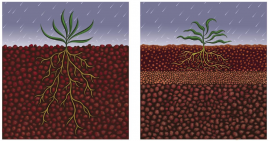 These soil-damaging factors combine to seriously limit plant growth and yields. When compacted layers form, water absorption is prevented and root growth is restricted, prohibiting the plants access to nutrients.
These soil-damaging factors combine to seriously limit plant growth and yields. When compacted layers form, water absorption is prevented and root growth is restricted, prohibiting the plants access to nutrients.
Helpful soil microbes and earthworms are reduced or eliminated because poor soil structure causes pastures to become waterlogged quicker, dry out faster, and often make tillage operations almost impossible.
Traditional cultivating practices are always aimed at controlling weed growth and preparing a fine "seedbed". Unfortunately these practices destroy soil humus, expose soil particles to erosion, compact the soil, restrict moisture penetration, and reduce root growth and plant yields.
The Problem of Soil Compaction
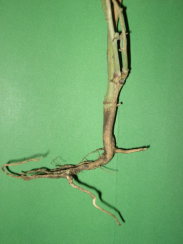
Normal farming activities using tractors, implements, headers, vehicles, cultivation, livestock and irrigation will cause soil compaction. The weight of vehicles and livestock compress the soil. Cultivation breaks down soil aggregates, soil structure, porosity and humus. The worst damage occurs in wet soils, with high stocking rates, frequent vehicle traffic and intensive cultivation. Any activity that reduces the porosity or bulk of your soil is causing soil compaction.
Compacted soil becomes denser and in turn, decreased porosity of the soil reduces:
- Water infiltration
- Humus levels
- Soil aeration
- Water drainage
- Worm activity
- Microbe activity
- Water retention
- Root growth
- Crop yields
How Compaction Is Rectified
- Break up compacted soils, hard pans, clay pans, tillage pans and impenetrable barriers with Non-Inversion Tillage.
- Re-establish plants with strong, deep root systems to rebuild and hold the soil structure, bulk and porosity in a healthier state - Preferably using direct drilling or minimum tillage techniques.
- Use farming practices that minimise soil cultivation, soil inversion and traffic in wet soils.
The Advantages of Non-Inversion Tillage
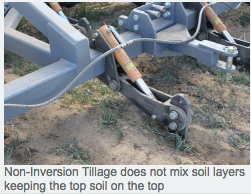 Non-Inversion Tillage can be used in both primary and secondary tillage operations, without soil inversion and minimising moisture loss. The narrow edge-on tine design substantially reduces tractor horsepower requirements.
Non-Inversion Tillage can be used in both primary and secondary tillage operations, without soil inversion and minimising moisture loss. The narrow edge-on tine design substantially reduces tractor horsepower requirements.
The low angle digging tool and narrow shank design ensures that the previous crops' root systems are fully retained in the soil thus improving structure, adding humus, increasing infiltration and holding moisture whilst allowing greater utilization of nitrogen created by legume Rhizobium bacteria.
Non-Inversion Tillage can be successfully applied in most situations. It has been used extensively in the farming of cereal, cotton, sugar, vegetables, vineyards and orchards under both dry land and irrigation farming methods. Non-Inversion Tillage is particularly effective in pasture renovation and the control of water run-off, allowing infiltration and storage within the soil. Wind erosion is reduced and salination problems can be reduced.
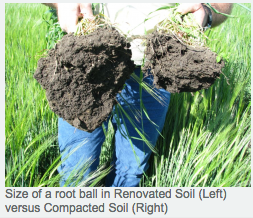 Hardpans and barriers, created by fine particles moving downwards into the coarse soil structures creating an almost impenetrable layer, can be eliminated. Benefits include wheat roots being able to penetrate the ripped soil faster and deeper to absorb more soil moisture, capture more soil nutrients and improve yield.
Hardpans and barriers, created by fine particles moving downwards into the coarse soil structures creating an almost impenetrable layer, can be eliminated. Benefits include wheat roots being able to penetrate the ripped soil faster and deeper to absorb more soil moisture, capture more soil nutrients and improve yield.
The shank is set to work below the compacted plough pan to uplift and shatter it without inversion of the soil. Soil particles become aerated without violent separation while allowing greater moisture penetration and infiltration into the bed. This minimizes fine soil aggregates and creates conditions ideal for microbial action.
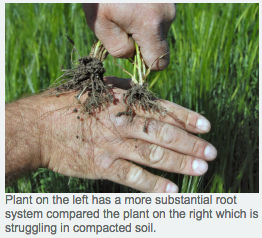 Crop roots are then free to pursue moisture and nutrients deep in the soil. Crop rotation and the planting of deep-rooted legumes also assist in developing and maintaining a healthy root bed.
Crop roots are then free to pursue moisture and nutrients deep in the soil. Crop rotation and the planting of deep-rooted legumes also assist in developing and maintaining a healthy root bed.
Non-Inversion tillage allows the legume roots to develop deep in the soil profile where nitrogen-fixing bacteria produces nodules. This not only increases nitrogen in the root bed but also organic matter, which gives a fertile, friable soil structure.
Non-Inversion Plows have been engineered to operate in a wide range of soil conditions whether they are black, heavy soils or the light, sandy, abrasive types. Soil type does not affect successful Non-Inversion Tillage.
